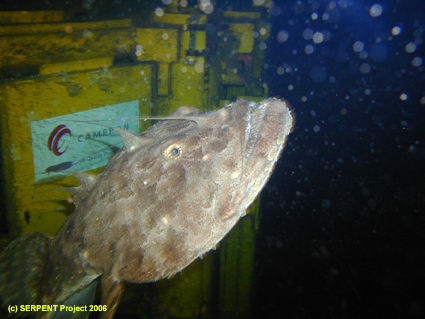 |
| Image: Wikimedia |
Whatever you call these monsters in your part of the world, it's ever apparent that we're talking about some kind of fish!
I have to say, I absolutely ADORE Monkfish! They have a fearsome, googly-eyed ugliness all their own and appear as little more than a face. It's like a giant ogre lost a battle with a huge amount of quicksand.
There are 8 species of these mostly Atlantic anglerfish in the genus Lophius, related to the vibrant Frogfish and all those deep sea Monstrosities we know and love.
As such, they have the illicium and esca (rod and lure) for attracting prey, the gigantic mouth for swallowing it and the distensable stomach to contain more food than they really should.
 |
| Image: Biomimetica via Flickr |
I presume they get their "Headfish" name from looking like a massive head resting on the ocean floor. Perhaps the same goes for "Monkfish", although that must be one ugly monk! They even have some sort of beard on their chin, probably just some extra skin to break up their shape and improve the camouflage.
It should be noted that Monkfish aren't strictly deep sea fish, although the various species have wide ranges that end at quite a depth.
Almost all deep sea anglerfish are pelagic, swimming far above the sea floor with the near spherical body shape of a very hungry and lazy version of that lifestyle.
Monkfish on the other hand are extraordinarily flattened for a stationary, benthic life at the very bottom of the ocean Still lazy, but a different kind of lazy.
Waving their lure around attracts prey but since it isn't bioluminescent, they need enough light around for their potential marks to actually see it.
 |
| Image: Alfiero Brisotto via Flickr |
Monkfish are motionless ambush predators. Perhaps they succeed at depth because they scarcely need to move at all. They can actually swim if they must, but they are sluggish and it's clearly not their forté
The lure is made of a ray that would otherwise be part of the dorsal fin. It's omnidirectional, moving left, right, up, down and all around. At its tip is a little... thing. A thing that is clearly of great fascination to passing fish who hope it's a tasty little... something.
When Monkfish finally attack, it's shocking to behold. The speed is terrifying. The strength and size of this beast is suddenly revealed in a deadly blur and rapacious belly.
Sometimes they actually have to remove their lure from the prey's mouth, and swallowing a big fish can be a whole other mission in itself.
When it catches something really substantial. you feel there should be several more metres of body behind that head. Maybe even four legs and a tail.
 |
| George returned with the dragon's head. Many were unconvinced. Image: Wikimedia |

Livin' it large! |

But where's the other half? |

OM NOM NOM NOM |

Flirtatious Monkfish reveals sexy underbelly |
Images: SERPENT Media Archive Project
Of course, Monkfish don't actually require 4 legs, and it's not just because they're fish.
 |
| Image: Biopix, N Sloth |
Another departure from their deep sea relatives is that male Monkfish are proper, individual fish with interests (eating), recreational pursuits (eating) and a full, intellectual hinterland (eating). Mainly they like eating. Which is more than can be said for the parasitic males of their deep sea kin.
 |
| I'm pretty darn sure this is a baby Monkfish. 34 mm long. Image: Museum of Comparative Zoology, Harvard University |
I'm sure those little ones can't wait to get out of there...
 |
| Image: WoRMS for SMEBD |


I, too, adore the monkfish. You've put together a wonderful exposition so we all may experience the greatness of this deep sea giant head.
ReplyDeletei love their big scowly faces. :)
ReplyDelete@shewalkssoftly: Thank you! Glad you enjoyed it!
ReplyDelete@TexWisGirl: I'm pleased you say that! Of course, if you didn't like the head, there wouldn't be much else besides you could like about them!
Gah! Evil pancake!
ReplyDeleteYeh, a pancake that'll take your arm off and grind your bones to make is bread!
ReplyDeleteThese are delicious. I consider them the second most delicious fish, behind torpedo rays.
ReplyDeleteSounds like you have a whole bellyful of monsters!
ReplyDeleteReally enjoyed this article!
ReplyDelete